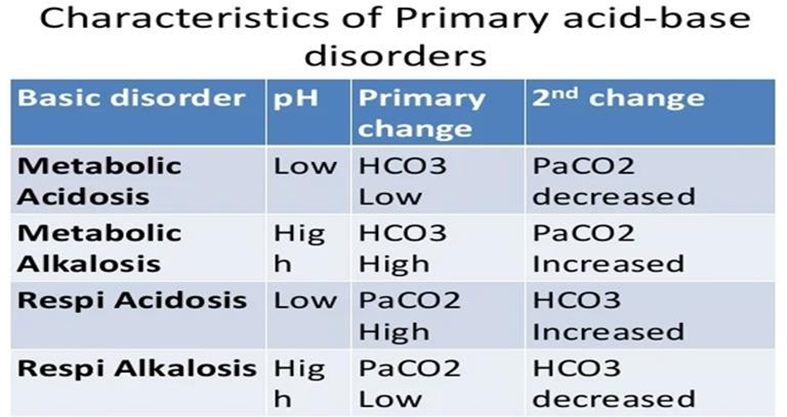A client is admitted with a suspected opioid overdose and a respiratory rate of 6 breaths per minute. Which of the following data would the nurse anticipate? (SELECT ALL THAT APPLY)
pH 7.29
Pa CO2 54
pH 7.51
PaO2 72
Pa CO2 31
Correct Answer : A,B
A. pH 7.29: A respiratory rate of 6 breaths per minute suggests hypoventilation, which can lead to respiratory acidosis due to retention of carbon dioxide (CO2). A decrease in pH (acidosis) is expected in this scenario.
B. PaCO2 54: In respiratory acidosis, PaCO2 levels are elevated due to inadequate ventilation, leading to CO2 retention. Therefore, an elevated PaCO2 level would be anticipated in this situation.
C. pH 7.51: A pH of 7.51 indicates alkalosis, which is not consistent with the expected respiratory acidosis in the context of opioid overdose and hypoventilation. Therefore, this choice is not anticipated.
D. PaO2 72: Oxygenation may be impaired in opioid overdose due to respiratory depression, but this PaO2 level is within the normal range. Hypoxemia is not typically a prominent feature of respiratory acidosis unless there are concurrent respiratory conditions or complications. Therefore, this choice is not anticipated.
E. PaCO2 31: A PaCO2 level of 31 indicates hypocapnia, which is not consistent with the expected respiratory acidosis in the context of opioid overdose and hypoventilation. Therefore, this choice is not anticipated.

Nursing Test Bank
Naxlex Comprehensive Predictor Exams
Related Questions
Correct Answer is D
Explanation
D. In metabolic acidosis, the pH would be low (acidemic) and the HCO3 level would be below the normal range. In the provided ABG results, the pH is low (acidemic) and the HCO3 level is below the normal range, indicating metabolic acidosis.
A. In respiratory alkalosis, the pH would be elevated (alkalotic) and the PaCO2 would be below the normal range (hypocapnia). However, in the provided ABG results, the pH is low (acidemia) rather than high, ruling out respiratory alkalosis.
B. In respiratory acidosis, the pH would be low (acidemic) and the PaCO2 would be above the normal range (hypercapnia). However, in the provided ABG results, the PaCO2 is within the normal range, ruling out respiratory acidosis.
C. In metabolic alkalosis, the pH would be elevated (alkalotic) and the HCO3 level would be above the normal range. However, in the provided ABG results, the pH is low (acidemic) and the HCO3 level is below the normal range, ruling out metabolic alkalosis.

Correct Answer is ["C","D"]
Explanation
C. Providing relief from pain and other distressing symptoms is a fundamental aspect of hospice care. The nurse should assess the client's pain level and other symptoms such as dyspnea, coughing, and restlessness, and intervene accordingly. This may involve administering analgesics, antitussives, or other medications as appropriate to alleviate discomfort and promote comfort and quality of life.
D. Placing the bed in semi-Fowler's position (with the head of the bed elevated) can help improve respiratory mechanics, ease breathing, and reduce respiratory distress in clients experiencing dyspnea. This position allows for better lung expansion and can facilitate the drainage of respiratory secretions, thereby promoting comfort and alleviating symptoms. This intervention does not typically require a medical order and can be implemented by the nurse based on clinical assessment.
A. Calling for transportation to the hospital may not be necessary or appropriate in this situation, especially considering that the client is under hospice care and experiencing changes in respiratory status and restlessness, which could be indicative of end-of-life processes. Hospice care focuses on providing comfort and symptom management in the home setting, and hospitalization may not align with the client's goals of care at this stage.
B. Initiating low-flow oxygen per nasal cannula may be appropriate to provide comfort and relieve hypoxia if the client is experiencing respiratory distress. However, this intervention would typically require a medical order, as oxygen therapy should be prescribed based on assessment findings and clinical indications.
E. Administering anti-anxiety medications may be considered if the client is experiencing significant anxiety or agitation that is distressing and impacting their comfort. However, the decision to administer anti-anxiety medications should be based on thorough assessment and consideration of the client's overall condition, goals of care, and potential risks and benefits. This intervention would typically require a medical order.
Whether you are a student looking to ace your exams or a practicing nurse seeking to enhance your expertise , our nursing education contents will empower you with the confidence and competence to make a difference in the lives of patients and become a respected leader in the healthcare field.
Visit Naxlex, invest in your future and unlock endless possibilities with our unparalleled nursing education contents today
Report Wrong Answer on the Current Question
Do you disagree with the answer? If yes, what is your expected answer? Explain.
Kindly be descriptive with the issue you are facing.
